
Report 2024
by Andy Parker, a participant
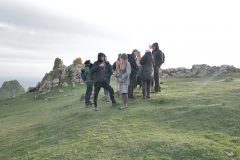
Imagine you’re on an Island…
The tenor of the 2024 Cornwall Workshop was set in a letter to participants from lead artist, Mike Nelson. With thoughts rooted in the pandemic, the writing considered Robinson Crusoe’s approach to surviving isolation, and what the parallels were between his 16th-century period of expansion and our current moment. I was drawn to the uncertainty that infused the letter, its mention of peripheral glimpses and its focus on the individual in relation to mysterious and shifting webs of commerce, wealth and power. It outlined a loose series of local explorations, seeking prompts and misunderstandings amongst cultural sites of all epochs in the landscape of the Lizard Peninsula. It promised “A lot of questions and no clear structure to obtain any answers…”
•••••••••••••••••••••••••
Friday 8th March, 2024
It was 5.45pm. Quite unplanned, and from the scattered corners of South West England, most of the group arrived at Kestle Barton at the same moment. It was as if we’d been washed ashore from a wreck, united by the good fortune of having made it, all scattered baggage and introductions. We headed for the dining room, where we congregated to eat and drink and get to know each other. The incredible food and hospitality we experienced that night continued throughout the week and gathering round the table each day became an important focus. With food came drink, and after the drink a very welcome sleep.
•••••••••••••••••••••••••
Saturday 9th March
Terrifying. I had checked my emails and found that yesterday, whilst travelling, we were sent some guidance about things to bring and notification that on Saturday “we’ll ask each of you to give a brief (10 to 15 minutes max) informal presentation”. A sense of trepidation filled the air: ‘Informal’, it said… Relaxed… Relax!
The care taken in selecting the group became clear as subtle links between our creative practices emerged through an intense day of fourteen presentations. Ideas were clearly anchored to stuff in the world, but this materiality had a range that took us from sampling a jar of fermented cabbage to sharing out a mound of small ceramic car tyres. I ended the session happy to be in such good company.
In the evening a suggestion was made for a walk to Frenchman’s Creek. Like a group of smugglers, we strode into the blackness of the night, exchanging subdued yarns through the valley until we could sense the water below. An instruction was given for silence… hush… shhh!… so we stood… quiet. The reflections of the odd star seemed distant but the lapping of water and the bubbling, creaking, oozing of the mud felt like it was all around us. Daphne du Maurier’s novel, ‘Frenchman’s Creek’, was written about this very place. It tells of a dashing seventeenth-century French pirate, who seduces an aristocratic lady visiting her Cornish estate from London. His sophisticated presence offers her an adventurous escape from a loveless marriage. She joined the pirate crew, but, in the end, for the sake of her children, returned to her husband. We went home for a few drinks before bed.
•••••••••••••••••••••••••
Sunday, 10th
Solidarity increased as we donned identical blue overalls. We’d signed an insurance waiver and been warned of some tight squeezes, but trepidation rose as we buckled into harnesses and hard hats… We waved goodbye to those members sensible enough to substitute exploring a tin mine for a walk along the coastal path with a flask of tea. Descending into the rock we negotiated ladders and slid through shoulder-wide gaps, dropping feet first into chill darkness. Feeling physically estranged in our outfits, and forcing ourselves one by one into the unknown, focussed our conversation on physical limits and ageing bodies. This morbid trend was amplified as we regrouped in a cramped cavern, stood in silence, and followed the instruction to turn our headlamps off. I struggled to make sense of this novel, timeless, sensory deprivation. I’d been standing for a second… or five seconds, ten seconds?..maybe a minute?..five? I could hear the voice of Rosencrantz in my head: “Do you ever think of yourself as actually dead, laying in a box with a lid on it? Nor do I really. Silly to be depressed by it. I mean, one thinks of it like being alive in a box. One keeps forgetting to take into account that one is dead.” The sensory and temporal ambiguity had a real weight, so it was a relief to refocus on Amy Dickson describing the concepts of proprioception and interoception, and to understand our mind’s ability to allow us to ‘see’ our fingers moving in front of our eyes despite the profound darkness.

Our guide filled us in on the incredible feats and endurance of the people who extracted tin ore from the thin veins rising vertically through the hard granite. His chirpy demeanour was a tonic as we navigated the oppressive voids, giving our best guesses to his ‘hows’ and ‘whys’ of mining techniques that went back through thousands of years of labour and exploitation. I was totally absorbed by this exploration within time, space and matter, but then we had to take part in an obligatory reel for social media and the spell was broken. The surface had found us.
We slithered out of our uniquely scented boiler suits and regrouped on the beach for some welcome cake. John Wedgwood Clarke looked out across the sea, and I had the sense he was soaking up every bit of the sensory blast of ocean, wind and sunlight as it crashed, rumbled and reflected off the rounded boulders of the beach. Alive. Here. Now. We sheltered ourselves, looking out towards the Brisons. In 1851 the ship New Commercial was blown onto those enormous black rocks. The crew clung on to a ledge overnight, becoming the focus of a perilous rescue attempt under the gaze of thousands of onlookers. In the morning a huge wave washed all, except the Master and his Wife, away.
Time for a jaunt over to CAST in Helston to join the public audience for a presentation by Caitlin DeSilvey, which linked Mike Nelson’s ‘The Asset Strippers’ with the Historic Object Collection of Clarks’ shoe factory. Caitlin’s research specialism of cultural geography tackles anticipatory histories and their role in industrial landscapes threatened through climate change. I share her interest in obsolescence and the past lives of objects. In the discussion that followed Mike explained his family background in engineering. This direct link between tangible human emotions and the politics of labour and capital represented in ‘The Asset Strippers’ particularly interested me. Perhaps it’s what makes defining obsolescence so important and tricky – it’s a moment of falling from use, of being superseded, but it’s the moment before the object accrues any novel anachronistic historical or aesthetic value. Maybe in this twilight, in-between moment some sense of emotional investment lingers, a sense of an object abandoned to complexities, becoming wholly visible like a stricken ship pivoting skyward before plunging to the depths of historicity.
We remained in the packed screening room at CAST to watch ‘The Colour of Pomegranates’, by Sergei Parajanov. This mysterious film was chosen by Mike. The chapters set in place a structure that lent shape to our unfolding week ahead; each new experience was a new scene or zone, linked but distinct from the rest. This is an incredible film, it really stayed with me even after such a physically and psychologically full day. It was an assemblage of surreal and dialogue-free tableaux: a boy on a roof surrounded by wet books, a stone church filled entirely with sheep, or a renowned installation artist disappearing from view as they are lowered by rope into the unknown depths of a Cornish tin mine.
After we had shared a meal with members of the wider CAST community, Tom Skinner drove us back to Kestle Barton in the twenty-year-old metallic yellow Peugeot he’d inherited from his grandfather.
•••••••••••••••••••••••••
Monday
KEEP OUT!
We started the day with a walk to the coast via an old quarry. With the weather fine and bright our descent through winding gravel tracks was beautiful and quiet. Abandoned excavations and stagnant pools reflected jagged granite, softened by seductive blooms of deep yellow gorse. As John stood ankle-deep in water, Mike and Donna Mitchell reminisced about the 1970s BBC Television series ‘Survivors’. I’d not heard of it, but the prescient storyline explored the ramifications of a global pandemic, following individuals around the country as they reacted to the loss of known civilisation by re-learning old skills to adapt to their new world. It felt like we were on set as we wandered round this sculpted zone of mass and form. We each found something of interest; from giant, empty gravel storage bays, to huge tyres embedded in the sand of the beach below.
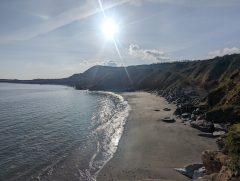
Squeezing through a fence, Tom Kaniok led the group to Lowland Point. Moving from a site of recent stone extraction to an area of Mesolithic flint working took us from a scarred, vertical architecture of shuttered concrete and fences, to a soft, grassy flatland, where eroding soil banks were littered with driftwood (and two dolphin spines). As we walked, Sam Trenerry explained the world of cultural communications and the web of relationships required to get high profile publicity for art projects. Stopping near a mound that I assumed to be a long-barrow, Tom told us about the bronze-age activity evident here and helped our eyes recognise pieces of pottery washed out of the soft earth. The quantity of fragments suggested an intense, practised process taking place right here. During his presentation, Charlie Duck had made light of a series of wood-fired kiln failures, and said of his endeavours with ceramics “I have a working knowledge, but I don’t want to know too much”. I thought of Robinson Crusoe’s determination to make ‘earthen vessels’ and the trial and error involved: “it would make the reader pity me, or rather laugh at me, to hear how many (…) odd, misshapen, ugly things I made”. Virginia Woolf in ‘The Common Reader ‘saw Crusoe’s efforts rather differently; “Thus Defoe, by reiterating that nothing but a plain earthenware pot stands in the foreground, persuades us to see remote islands and the solitudes of the human soul. By believing fixedly in the solidity of the pot and its earthiness, he has subdued every other element to his design; he has roped the whole universe into harmony.”
Then everybody went swimming.
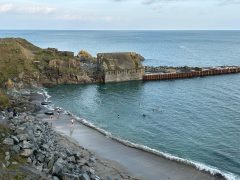
Retracing our steps up from the beach, we could hear a helicopter approaching. It swung round the headland behind the quarry, roaring overhead as we were helping each other back through the hole in the fence. It was very close to us, massive and grey, with a person sitting in the open door looking at us… Our pace quickened as we made for the car park. The helicopter circled again, watching as we ascended, its booming rotor blades echoing around the quarry’s sparse geometry. Mike’s introductory letter described the Covid pandemic as occupying ‘a space of dreamlike unreality’ and this scene gave form to that – each of us conscious of observing and being observed, self-aware, uneasy. The helicopter’s sinister presence dropped from sight just as we reached the cars. We didn’t hang around.
We paused at the New Inn for a reassuring pint before dinner. This place was something of a local success, having been saved from closure and refurbished by a local cooperative group. Gazing down at the patchwork of new flagstones in this centuries-old pub, it became apparent that many were identical. The slabs weren’t stone at all, but were huge tiles printed to look like stone. A mechanically mass-produced picture of an old pub floor.
•••••••••••••••••••••••••
The next day. (Mist)
We congregated at Gwennap Pit to hear John recite some of his poems and share his experiences of the pit’s Methodist roots. He encouraged us to explore the acoustics of the unusual earthwork, whose stepped-sided form sunk deep into the earth. It was powerful to experience his work spoken here; it reminded me how long it’s been since I’ve heard somebody speak with a relish for the feeling of words in the air. After pasties for lunch, Harriet Bowman was encouraged to initiate a few choreographed circumambulations with the group. Given more time and a costume department, I think something wonderful would have evolved from that.
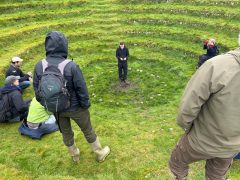
Mike went off to Falmouth to prepare for a presentation and the rest of us proceeded to the Poldice Valley to explore what was once an extremely busy industrial area and, much later, the place where Donna played as a child. It is a picturesque site that I’d cycled through a few years ago, dotted with derelict buildings leaching blue minerals from their blackened stones. Its peculiar blockwork labyrinths are the remains of an arsenic extraction plant. Fumes from locally mined ore heated to 600 degrees would gradually cool as they wound their way through the twisting, brick tunnels, depositing arsenic powder on the walls. “After cooling, mine workers would go in and scrape the arsenic powder off the walls and collect it. Safety equipment included cotton wool nose plugs, handkerchiefs for breathing through and arms smeared with clay.” Arsenic green wallpaper was rumoured to have poisoned Napoleon as he endured his genteel exile on the Island of St Helena. As we walked back to the cars we passed a derelict speed boat in a field of sheep. There is no escape from the island.
The lecture theatre at Falmouth was full and there was a fantastic buzz as the audience waited to hear Mike in conversation with Jonty Lees, course leader of Fine Art. I was so absorbed I made no notes at all, except for jotting down Mike’s enigmatic phrase ‘searching for sense’.
•••••••••••••••••••••••••
(Sunshine)
I woke early and cycled to St Keverne churchyard where hundreds of shipwreck victims are buried in mass graves under surprisingly modest memorials. There is another mass grave at Lowland Point. The bronze-age burial mound we stood next to a few days ago was actually formed by the hasty disposal of 34 horses of the 7th Hussars, washed ashore from the wreck of the Dispatch, which struck Meyn Eglos on the 22nd January 1809.
I returned to Kestle Barton and joined an informal group conversation with Mike. It was a huge privilege to see behind the scenes of an art practice whose public face is so familiar, and to understand the way opportunities arise and works fall together, or sometimes don’t. I’d made a note to find out more about the relationship between his objects and their site, and how the wheel, stilt, raft, leg, prop, stage, mirror are all employed to trouble any sense of anchoring. As I thought back to the group presentations, this real or implied mobility was present in many of the practices, from the ladders and turntables of Jo Lathwood, to Harriet Bowman’s cars, the dynamic kinetic work of Amy Morgan. We were all floating.
It was a glorious afternoon for a walk, so we drove to Kynance Cove. Ascending to a spectacular cliff top, we could look out over the shipping area of Plymouth, toward Biscay, Fitzroy and Sole (good to put a face to those late-night, Radio 4 names). The walkers took shelter from the wind to enjoy the sunshine and share insights from the night before. I had run out of talk, so stared at the waters of the English Channel, wondering how many times my ancestors had sailed over that horizon.
Our walk from here felt something more akin to a route march, destination unclear. Trudging over the sodden heathland I was absorbed in conversation with Jessie Blindell, learning about her project at Flat Holm Island and how she unpicks and re-tangles the complex stories of such a place. She told me about the gulls which connected the island to the mainland with their flight-paths; their transfer of junk-food chicken bones and waste ultimately leading to the spread of disease. Jessie described the fires used by Flat Holm’s wardens to cremate the gull corpses (I later learned the island’s isolation hospital had been cremating the diseased bodies of sailors long before that). Island thinking seems to be a constant oscillation between yearning for connection and fearing its threats. The conversation ended suddenly at an airfield where we were confronted by enormous scorched steel structures, recognisable as aircraft but made strange by their lumpen lack of finesse and their burnt-out interiors. Helicopters, flight-paths and cremations converged so I was glad to continue on our way. As the sun set, the walk went on, wetter and wetter underfoot until, eventually, darkness…and a pub.
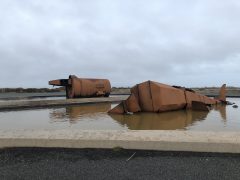
•••••••••••••••••••••••••
Drizzle
A brief hike up the road from Kestle Barton brought us to the workshop of Greg Powlesland. Billed as a boatbuilding workshop, this was not the ramshackle kind of space I’d expected; it was carefully zoned into areas for different materials and processes. Greg toured us round, awed by his collections of dusty boats, dockyard timbers, industrial salvage, vintage vehicles. We moved from the metal workshop to stone working area, from the woodworking room we wandered into the art studio, with its areas separated for print, clay, drawing, sewing. Mike and Greg discussed their shared passion for old tools and we all found something to pique our interest in these curated tableaux (for me it was a ghostly painting of a white-sailed and white-hulled ship, floating on light great waves under a pale sky – Greg said it was painted by a man who had lived next door, a sailor of yesteryear – reminiscent of the sophisticated pirate in Du Maurier’s ‘Frenchman’s Creek’). It felt as if we were searching for something in those workshops: a problem to solve or a stone left unturned, but somehow it all felt like answers (if we’d have been looking to build a raft it would have come out beautifully varnished with brass fittings). Some of us ended the visit with a very brief dip in the cold water of the Helford River (next to Greg’s beautiful yacht) whilst the rest sheltered from the rain (next to Greg’s beautiful boathouse).
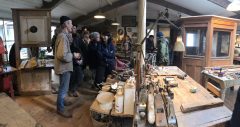
A writing workshop with John brought structured activity to the dining room. He guided us to reflect on our week so far, and we had to write incredibly brief passages about the places we’d encountered. We didn’t share our work, but we talked about the productive experience of writing in a group and under such time pressure. I’d made a note during John’s introduction “…not to startle the strangeness away” (I think it was a quote from the poetry of Louise Glück). It recalled a conversational theme of the week prompted by Mike’s letter; “This flickering in and out of focus is what interests me within a work of art, the glimpse of something beyond its components and its return back to the very same matter.” The pressures of this exercise prevented over-thinking and allowed many of us to achieve this in our short texts. Mike related it to trusting your peripheral vision. The strangeness is what we are trying to see.
Jo Lathwood suggested we share some audio visual work, so we all squeezed in front of a huge TV in a bedroom. Simon Dicker started with ‘The Flatlands’ and we discussed the writing and narration in its exploration of rural heaps and mounds, and their links to land art and the post-industrial landscape. Jo’s ‘The Belief in Things Disappearing’ took a reverse view, looking at the industry performing the magical disappearance of our domestic waste. The out-of-sight nature of the waste industry, and the obfuscatory language surrounding its management, was calmly unpicked by Jo’s dispassionate narration and the visuals of rubbish being processed, interspersed with a magician’s hands demonstrating tabletop magic. Tom Skinner shared another angle on storytelling with ‘He Lived for Steam’ – a beautifully filmed, personal work of visual anthropology, delving into complex relationships and motivations on a heritage railway. Amy Dickson shared a work from her gallery programme that embodied her interest in movement. A collaboration between a choreographer and film-maker, ‘Bowland Beth’ took its starting point from a poem about a hen harrier that is illegally shot. It was an evocative piece of choreography that took place in open moorland whose physicality expressed both power and vulnerability. The afternoon’s common thread seemed to be the agency of the individual in the face of (often absurd, often hidden) systems beyond their control.
•••••••••••••••••••••••••
Friday.
It was time to leave so I knew it was Friday. We packed up and shipped out of our haven at Kestle Barton, gathering at CAST for coffee and to reflect on the workshop through our writing and observations. As we shared our thoughts, a variety of perspectives on the week emerged, as much to do with the unusual intensity of our shared time as it was with our explorations. Maya noted the importance of the dining room as a zone of experience that united the activities of the group. The mug of teaspoons that sat on the dining table was her focus; an apt use for Crusoe’s earthenware container.
We moved to the screening room so Harriet could share a new sound work with us. It was the first time ‘Taking Care of the Yolk’, 2024 had been shared with a group, so it was a good chance to test it out and get some broad feedback before its public presentation in Plymouth a few weeks later. The work was highly textured, both in its layered sounds, and in the emotional tenor of the narration. Its carefully detailed description of preparing an egg bap was exactly to my preference. Laying down in a warm, darkened space got the better of a few of us, but this was a reflection on an exhausting week and not the work.
We had some soup, said our goodbyes and headed out. That was it. We were off.
The trains were out of action, so I gave Donna a lift back to Devon. This was a lucky chance to ease away from the experience gently, to chat about what we’d been through, and to talk about what’s next. We’d left the island, but as we hadn’t found any answers, it didn’t feel like it could be over. I drove on to Teignmouth for chips.
•••••••••••••••••••••••••
Unlike Crusoe, whose shipmates were reduced to the flotsam of three hats, a cap and two odd shoes, we had the benefit of considering our island in the company of a full crew. Seeing all participants take risks and share their successes and struggles felt very real, and filled me with hope and excitement. The South West is home to an incredibly engaged and connected creative network and I feel very lucky to have washed up here. The initial expectation of not finding answers was probably well met, but, as a team, new perspectives emerged. One person’s focus is another’s peripheral view.
Images courtesy Harriet Bowman, Teresa Gleadowe, Jo Lathwood, and Mike Nelson
